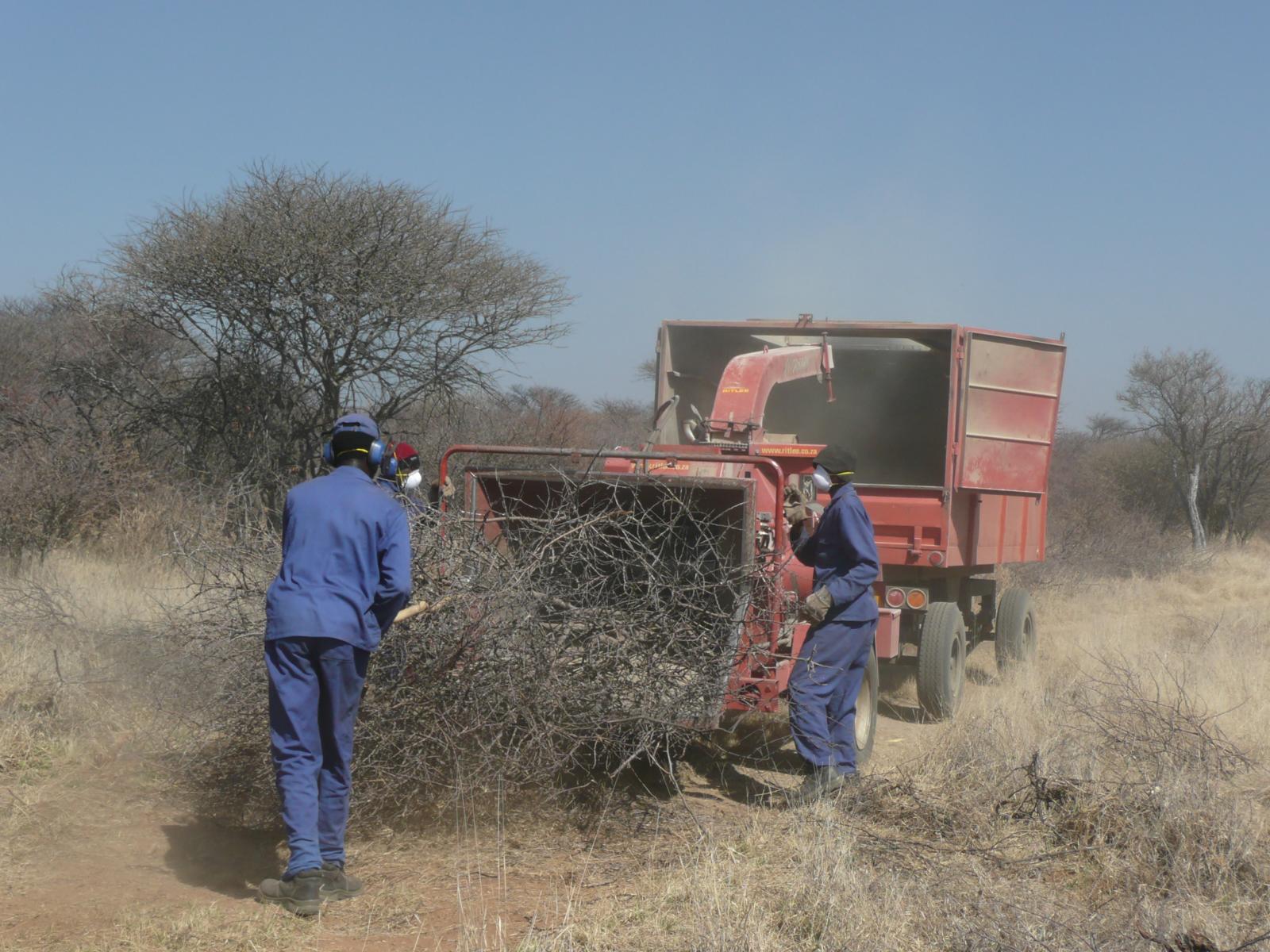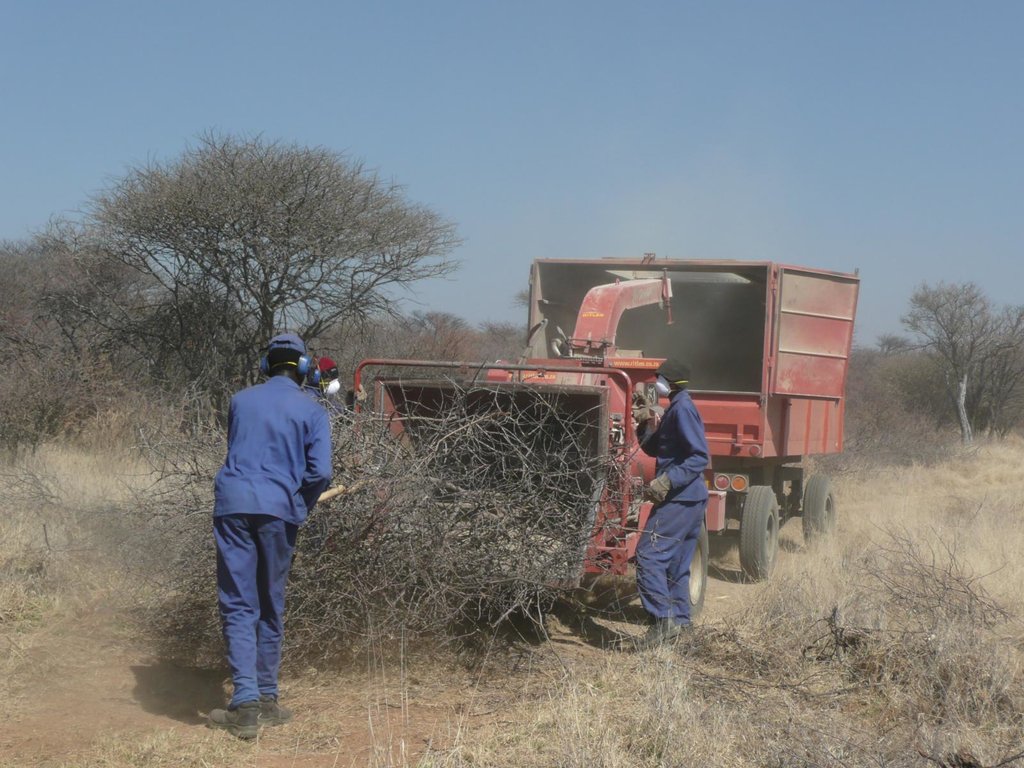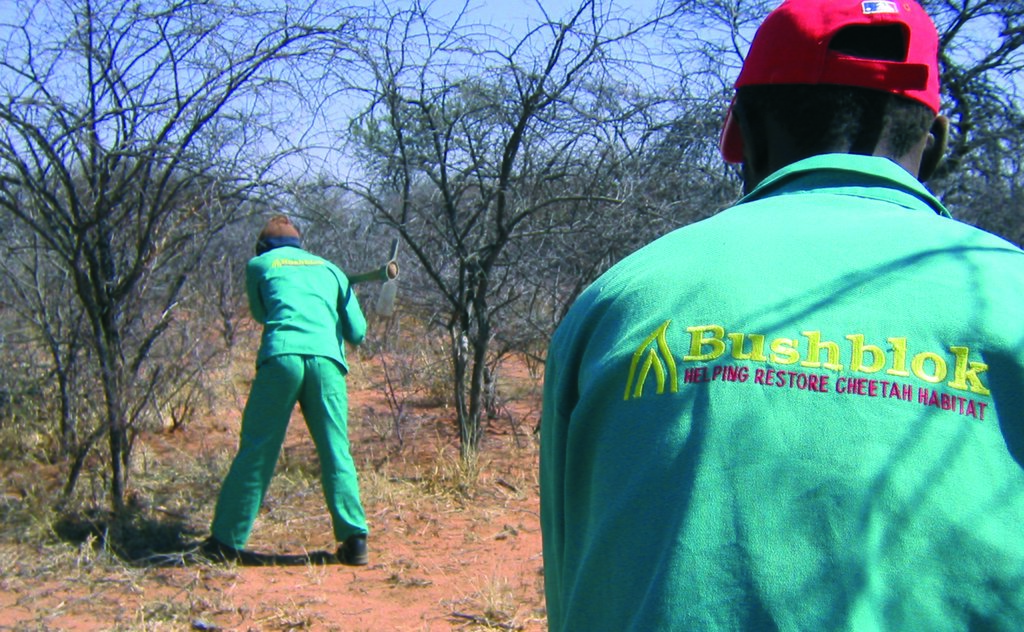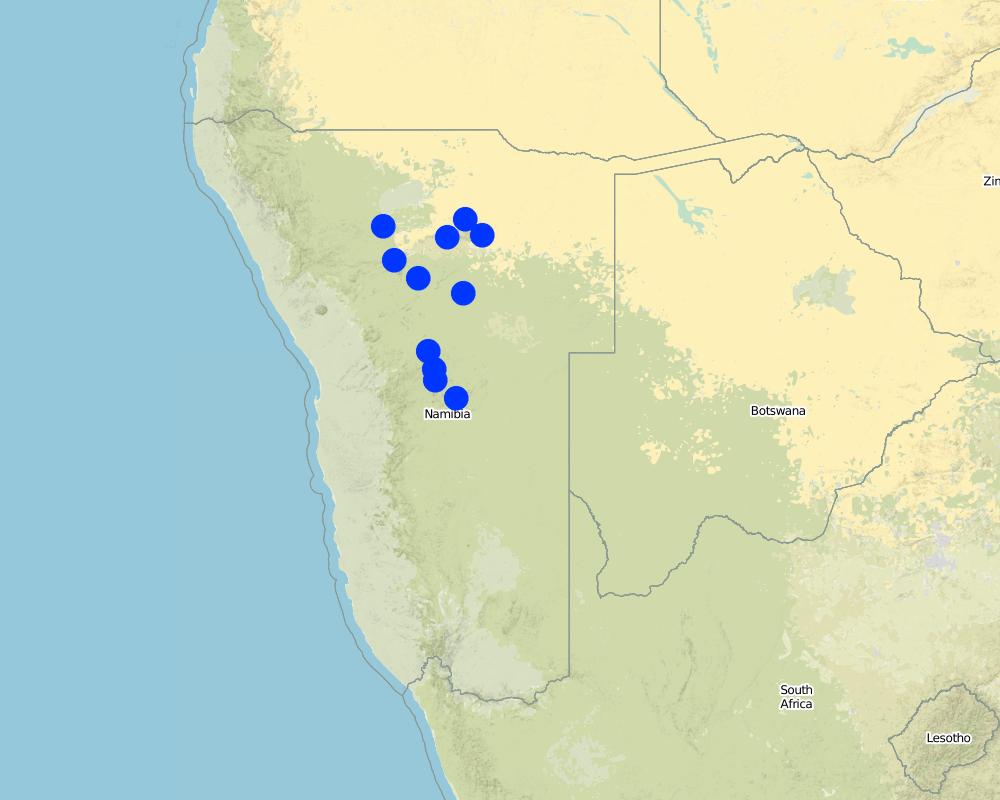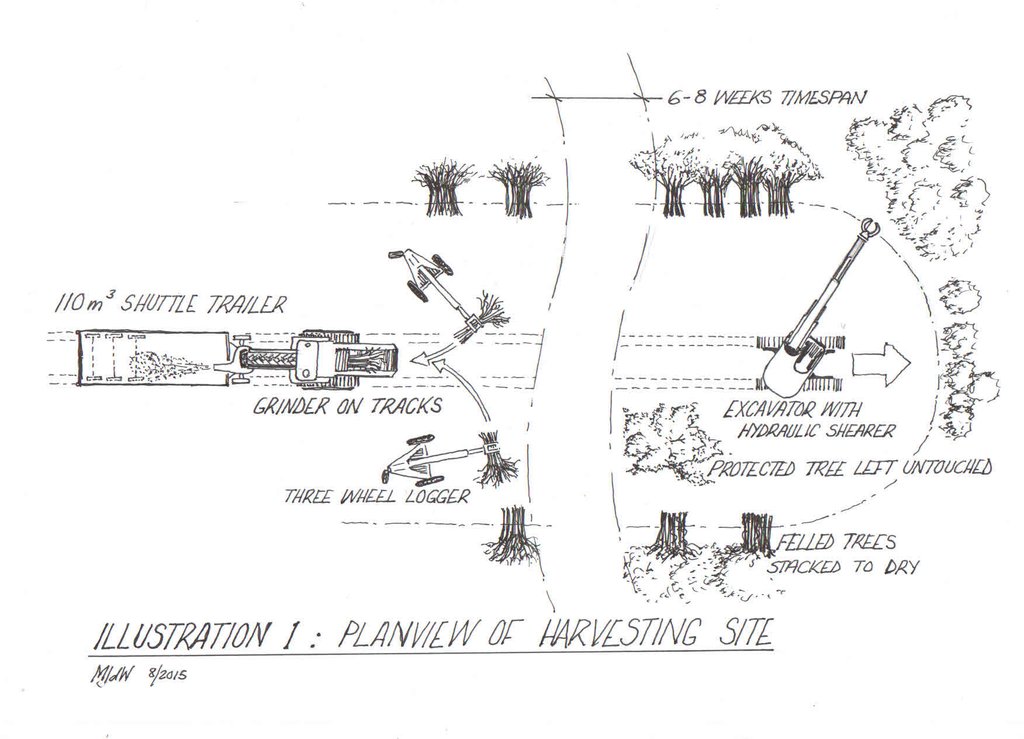Bush Thinning and Biomass Processing by Manual or Mechanised Means [Namibia]
- Creación:
- Actualización:
- Compilador: Johannes Laufs
- Editor: –
- Revisor: Rima Mekdaschi Studer
De-bushing
technologies_2203 - Namibia
- Resumen completo en PDF
- Resumen completo en PDF para imprimir
- Resumen completo en el navegador
- Resumen completo (sin formato)
- Bush Thinning and Biomass Processing by Manual or Mechanised Means: 17 de julio de 2018 (inactive)
- Bush Thinning and Biomass Processing by Manual or Mechanised Means: 31 de mayo de 2019 (inactive)
- Bush Thinning and Biomass Processing by Manual or Mechanised Means: 22 de agosto de 2017 (inactive)
- Bush Thinning and Biomass Processing by Manual or Mechanised Means: 2 de noviembre de 2021 (public)
- Bush Thinning and Biomass Processing by Manual or Mechanised Means: 21 de febrero de 2018 (inactive)
Visualizar secciones
Expandir todo Colapsar todos1. Información general
1.2 Detalles de contacto de las personas de referencia e instituciones involucradas en la evaluación y la documentación de la Tecnología
Nombre de la(s) institución(es) que facilitaron la documentación/ evaluación de la Tecnología (si fuera relevante)
Deutsche Gesellschaft für Internationale Zusammenarbeit (GIZ) GmbH (GIZ) - Alemania1.3 Condiciones referidas al uso de datos documentados mediante WOCAT
¿Cuándo se compilaron los datos (en el campo)?
01/08/2014
El compilador y la/s persona(s) de referencia claves aceptan las condiciones acerca del uso de los datos documentados mediante WOCAT:
Sí
1.4 Declaración de la sostenibilidad de la Tecnología descrita
¿La Tecnología aquí descrita resulta problemática en relación a la degradación de la tierra, de tal forma que no puede considerársela una tecnología sostenible para el manejo de la tierra?
No
Comentarios:
The technology described is a means to rehabilitate degraded rangeland. Through targeted harvesting of bushes, the bush density is reduced, allowing for better growth of grass.
1.5 Referencia al (los) Cuestionario(s) de Enfoques MST
2. Descripción de la Tecnología MST
2.1 Breve descripción de la Tecnología
Definición de la Tecnología:
On Namibian farmland bushes are harvested in order to reduce the excessive bush densities, that stiffle the growth of other plant species, especially grasses. Bush can be harvested manually (e.g. with axes), semi-mechanised (e.g. chainsaws) or fully mechanised (e.g. customised excavators). After cutting, the bush is typically left to dry and in a second step processed into a transportable format (e.g. wood chips).
2.2 Descripción detallada de la Tecnología
Descripción:
Bush thinning in the form of selective bush harvesting is applied on Namibian agricultural land. The main aim of the technology is the restoration of degraded rangeland, reducing bush densities, fostering the re-growth of grasses. According to the best available estimates about 45 million hectares of Namibian farmland are affected by bush encroachment. Bush encroachment negatively affects biodiversity, groundwater recharge and importantly the carrying capacity of rangeland. Bush encroachment equally hinders crop production, but this phenomenon is of less significance in Namibia due to the limited scope of crop production in the country. There is a multitude of causes for bush encroachment, among which overgrazing (i.e. overstocking with cattle or lack of rotational grazing), reduced frequency of wildfires and higher CO2 concentrations in the atmosphere feature strongly. Bush encroachment is not to be equated with the invations of alien species, since most encroacher species are indigeneous to Namibia
While it is believed that natural transitions in the ecosystems can on the long-run, under favourable climatic conditions, also lead to reductions of bush encroachment, active rehablitation measures are required in order to achieve improvements on the short-run. This is an aboslute necessity for many Namibian farmers, who experience severe economic difficulties due to the reduced productivity of their land.
Bush control comprises of responsive measures (bush thinning), follow-up measures (aftercare) as well as preventative measures (good rangeland management practices). Since vast areas of Namibian rangeland are heavily encroached by indigenous bush species, the focus is currently on responsive measures, i.e. bush thinning.
Bush thinning entails the practice of selectively harvesting a specified number of bushes, effectively reducing the number of bushes per given area. To determine the density of bush remaining after thinning, a formula based on tree equivalent (TE) and average annual rainfall is used. A tree equivalent is defined as a woody tree or bush of 1,5 metres in height. Thus, a 3 metre shrub would represent 2 TE, a 4.5 metre shrub 3 TE. As rule of thumb for estimating optimal bush density, about 30-35% of encroacher biomass should be removed. This rule is based on research that has been carried out mainly in South Africa over the past decades, measuring and comparing the re-growth experienced at various sites where bush had been harvested. Areas, in which too much bush was removed, experienced strong re-growth of bush, often resulting in even heavier bush encroachment.
Bush thinning follows strict environmental guidelines set by the Ministry of Environment and Tourism through the Environmental Management Act with regard to the equipment's used (avoiding negative side-effects such as disturbance of the soil) and the amount of bushes to be harvested (aiming at the right balance between reducing the encroachment and maintaining a healthy number of the desired bush species). The amount of bushes to be harvested must be determined by expert for each specific area and depends on various factors, e.g. soil type, topgraphy, severity of bush encroachment and intended land use type.
It is important to note, that as with most direct interventions in natural ecosystems, there is a lack of precise knowledge on the long-term effect of bush thinning and the appropriate intensity thereof. There is however no doubt that active bush control has an overall positive effect on the savanna ecosystem in Namibia.
In order to render bush thinning economically feasible, value chains have been developed. Through the processing and utilisation of the woody bush biomass, income can be generated and the cost of bush conrol balanced. Existing value chains include the production of charcoal, firewood, poles, bush based animal feed as well as heat and electricity. Value chains currently under development include composition materials, such as wood-plastic, wood-cement and bio-plastic.
Scientific observations have shown, that bush thinning cannot be implemented as a once-off activity, but requires regular follow-up to prevent the re-thickening of the bush. Follow-up measures (so-called aftercare) include the prevention of coppicing and re-growth. This can be achieved by applying aboricides selectively to the cut stems, stem fires or the introduction of browsers (e.g. goats). Research on the effectiveness and possible side effects of each of these methods is limited.
The need for bush control, and therewith bush thinning, is widely recognised among land owners and also acknowledged on the national political agenda.
A major challenge for the implementation of the technology is the limited suitability of available machines. The hardness and high mineral content of the woody biomass leads to high wear and tear on the equipment (both harvesting equipment and processing equipment, like chippers and pelletisers), often rendering operations unprofitable. Research into more suitable machinery is ongoing.
Further, the implementation of sustainable bush control must be improved through skills training and continuous monitoring of the long-term effects on rangeland.
2.3 Fotografías de la Tecnología
Comentarios generales sobre las fotos:
All photos have either been taken by the GIZ Support to De-bushing Project or were provided to the project by third parties.
2.4 Videos de la Tecnología
Comentarios, descripción breve:
https://www.youtube.com/watch?v=859GshR9hso&t=3s
Bush Encroachment in Namibia: Causes and Extent
An explanation of the root causes of bush encroachment and its impact on land in Namibia.
Fecha:
01/11/2015
Lugar:
Namibia
Nombre del videógrafo:
GIZ Support to De-bushing Project
Comentarios, descripción breve:
https://www.youtube.com/watch?v=bmlzPDiqlxo&t=45s
Biomass Value Addition: Bush Based Products
An overview of existing and potential value chains based on encroacher bush.
Fecha:
01/11/2015
Lugar:
Namibia
Nombre del videógrafo:
GIZ Support to De-bushing Project
Comentarios, descripción breve:
https://www.youtube.com/watch?v=MMSOfV2KBjA
Biomass Energy: From Bush to Electricity
Overview of the energetic applications of woody biomass from encroacher bush.
Fecha:
01/11/2015
Lugar:
Namibia
Nombre del videógrafo:
GIZ Support to De-bushing Project
2.5 País/ región/ lugares donde la Tecnología fue aplicada y que se hallan comprendidos por esta evaluación
País:
Namibia
Especifique más el lugar :
Bush control is applied across Namibia on many privately owned farms. Activities are most concentrated in the regions Khomas, Omaheke, Otjozondjupa and Oshikoto.
Comentarios:
Pointers on the map only indicate points (e.g. urban centres) around which activities are concentrated. It is not possible to depict each site where bush control is implemented due to the high number of individual activities and projects.
Map
×2.6 Fecha de la implementación
Indique año de implementación:
2015
2.7 Introducción de la Tecnología
Especifique cómo se introdujo la Tecnología:
- mediante la innovación de usuarios de tierras
- durante experimentos/ investigación
- mediante proyectos/ intervenciones externas
Comentarios (tipo de proyecto, etc.):
Since the 1950s the phenomenon of bush encroachment has been recognised by farmers in Namibia and counter measures have been implemented over the decades. The technologies applied largely relied on the means and innovative capabilities of the respective land owner. Only as of 2014, through the introduciton of a national Support to De-bushing Project, are technologies systematically researched and tested in the field.
3. Clasificación de la Tecnología MST
3.1 Propósito(s) principal(es) de la Tecnología MST
- mejorar la producción
- reducir, prevenir, restaurar la degradación de la tierra
- conservar el ecosistema
- preservar/ mejorar biodiversidad
- crear impacto económico benéfico
3.2 Tipo(s) actuales de uso de la tierra donde se aplica la Tecnología

Tierra de pastoreo
Tierras de pastoreo extensivo:
- Ganadería de hacienda
Especies y productos animales principales:
Cattle, goats, game
Comentarios:
Namibia is characterised by large commercial cattle farms. Du to its aridity the land is largely unsuitable for crop farming, with exceptions in high-rainfall areas such as the Grootfontein, Tsumeb, Otavi triangle.
The Northern parts of Namibia are managed as communal land, where farmers have lease holds for their land. In these areas a combination of millet production and cattle herding is common.
Si el uso de la tierra ha cambiado debido a la implementación de la Tecnología, indique el uso de la tierra antes de la implementación de la Tecnología.
The implementation of bush thinning allows to maintain the land use (e.g. cattle ranching) and is typically applied to increase productivity in the long-term.
3.3 Información adicional sobre el uso de tierras
Provisión de agua para la tierra donde se aplica la Tecnología:
- de secano
Número de temporadas de cultivo por año:
- 1
Densidad del ganado (si fuese relevante):
284 000 in targeted area of bush thinning (Otjozondjupa region)
3.4 Grupo MST al que pertenece la Tecnología
- pastoralismo y manejo de tierras de pastoreo
- cobertura de suelo/ vegetal mejorada
3.5 Difusión de la Tecnología
Especifique la difusión de la Tecnología:
- distribuida parejamente sobre un área
Si la tecnología se halla difundida homogéneamente en un área, indique el área aproximada que cubre:
- 1,000-10,000 km2
Comentarios:
Currently bush thinning is implemented on a total of approximately 120.000 hectares (1.200 km2) of farmland per annum. These activities are not confied to certain areas, but spread across all of Namibia, typically concentrating in the most encroached areas (e.g. Otjozondjupa, Khomas, Oshikoto and Omaheke regions).
3.6 Medidas MST que componen la Tecnología

medidas vegetativas
- V4:reemplazo o eliminación de especies extrañas/ invasoras

medidas de manejo
- M2: Cambio de gestión/ nivel de intensidad
- M5: Control/ cambio de composición de las especies
3.7 Principales tipos de degradación de la tierra encarados con la Tecnología

degradación biológica
- Bh: pérdida de hábitats
- Bq: reducción de la cantidad/ biomasa
- Bs: reducción en la calidad y composición/ diversidad de las especies
3.8 Prevención, reducción o restauración de la degradación de la tierra
Especifique la meta de la Tecnología con relación a la degradación de la tierra:
- prevenir la degradación de la tierra
- restaurar/ rehabilitar tierra severamente degradada
4. Especificaciones técnicas, actividades de implementación, insumos y costos
4.1 Dibujo técnico de la Tecnología
4.2 Especificaciones técnicas/ explicaciones del dibujo técnico
Drawing of a bush harvesting site layout. The drawing depicts fully mechanised bush harvesting and immediate processing into wood chips. This set-up is most suitable for large-scale bush thinning, e.g. for the purpose of supplying biomass in larger quantities. Such off-take includes the potential export of bush in processed form (pellets) or energetic utilisation (e.g. local biomass power plants or biomass boilers in the industry). Currently two such energy solutions exist in Namibia, one at a local brewery and one at a local cement factory.
Note that a range of bush harvesting methods exist, ranging from fully mechanised (as depicted) to manual bush harvesting (e.g. with axes). The site layout and principles are the same in all scenarios, but harvesting speed and costs differ.
The bush harvesting process:
Bushes are harvested selectively with and excavator, to which a hydraulic sheer cutter is attached. The biomass is stacked in rows and left for drying some six to eight weeks (depending on weather conditions). The biomass is then further processed with a chipper and collected with a trailer for further transport off the farm (e.g. to a biomass power plant or industrial off-taker). As a rule of thumb, one third of the standing biomass is removed, leaving two thirds standing. Harvesting starts with smaller plants and then moves to larger ones, cutting only plants with 15 centimetres of diameter or less (as per Namibian forestry regulations).
Cost of bush harvesting can be calculated per hectare (e.g. land owner's perspective) or per tonne (in fuel supply agreements with off-takers). All below stated costs are approximations, as costs vary widely depending on the local framework conditions on a given piece of land. Typically the costs to harvest bush on one hectare range from 2,000 NAD to 4,000 NAD.
4.3 Información general sobre el cálculo de insumos y costos
Especifique cómo se calcularon los costos e insumos:
- por área de Tecnología
Indique tamaño y unidad de área:
1 hectare
otra / moneda nacional (especifique):
Namibia Dollar (NAD)
Indique la tasa de cambio de USD a la moneda local (si fuese relevante): 1 USD =:
0,078
Indique el costo promedio del salario de trabajo contratado por día:
Namibia Dollar (NAD) 110
4.4 Actividades de establecimiento
| Actividad | Tipo de medida | Momento | |
|---|---|---|---|
| 1. | Bush harvesting/felling | Vegetativas | Year around |
| 2. | Stacking (and drying) | Otras medidas | Year around |
| 3. | Feeding the chipping operation | Otras medidas | Year around |
| 4. | Transport | Otras medidas | Year around |
Comentarios:
The restorative measure includes bush harvesting/felling as well as aftercare measures. Additional activities include the processing (e.g. into chips) and transport of the woody material off the farm/land.
4.5 Costos e insumos necesarios para el establecimiento
| Especifique insumo | Unidad | Cantidad | Costos por unidad | Costos totales por insumo | % de los costos cubiertos por los usuarios de las tierras | |
|---|---|---|---|---|---|---|
| Mano de obra | 1 x Mechanic | person days | 0,2 | 2000,0 | 400,0 | |
| Mano de obra | 4 x Operators | person days | 0,8 | 300,0 | 240,0 | |
| Mano de obra | 1 x Operation manager chipping | person days | 0,2 | 1000,0 | 200,0 | |
| Mano de obra | 1 x Chipping operator | person days | 2,0 | 150,0 | 300,0 | |
| Equipo | 1 x 12t Excavator | pieces | 1,0 | 120,0 | 120,0 | |
| Equipo | 2 x Hydraulic grab and shearing attachments | pieces | 2,0 | 60,0 | 120,0 | |
| Equipo | 2 x Three wheel loggers | pieces | 2,0 | 180,0 | 360,0 | |
| Equipo | 1 x Chipper | pieces | 1,0 | 840,0 | 840,0 | |
| Otros | Management and administration overhead | lump sum | 1,0 | 200,0 | 200,0 | |
| Otros | 12,0 | |||||
| Costos totales para establecer la Tecnología | 2780,0 | |||||
4.6 Actividades de establecimiento/ recurrentes
| Actividad | Tipo de medida | Momento/ frequencia | |
|---|---|---|---|
| 1. | Aftercare | Vegetativas | Annually |
Comentarios:
When land is thinned it creates a vacuum in which weeds and woody plants (sometimes more aggressive colonisers than the original encroacher species) will quickly establish themselves. Regular aftercare needs to be applied in order to prevent the excessive re-growth of bush (and therewith new degradation of the land). Various methods are in use to manage the re-growth of bush following harvesting. These include selective application of arboricides, stem burning, and intensive browsing by goats or antelopes.
The more sustainable the bush harvesting itself has taken place, importantly not completely clearing larger areas of vegetation, the less likely is agressive re-growth of bush. In all bush thinning exercises it is important to leave larger bushes and trees untouched and to start by removing the smaller, less established bushes. In addition, not only individual larger bushes must be left standing, but also islands/patches of bushes, which fulfill important ecosystem services, e.g. habitat for animals.
4.7 Costos e insumos necesarios para actividades de mantenimiento/ recurrentes (por año)
Si fuera posible, desglose los costos de mantenimiento de acuerdo a la siguiente tabla, especificando insumos y costos por insumo. Si usted no pudiese desglosar los costos, proporcione un estimado de los costos totales que se necesitan para el mantenimiento de la Tecnología:
500,0
Comentarios:
Commonly aftercare is applied in form of manual application of herbicides to the cut stems, in order to prevent re-growth of the bushes.
4.8 Factores más determinantes que afectan los costos:
Describa los factores más determinantes que afectan los costos:
(1) Investment in machinery (if not applied manually)
(2) Maintenance of machinery (high wear and tear due to hardness of wood and high mineral content)
(3) Remoteness of farms/land from buyers/markets
5. Entorno natural y humano
5.1 Clima
Lluvia anual
- < 250 mm
- 251-500 mm
- 501-750 mm
- 751-1,000 mm
- 1,001-1,500 mm
- 1,501-2,000 mm
- 2,001-3,000 mm
- 3,001-4,000 mm
- > 4,000 mm
Especifique el promedio anual de lluvia (si lo conoce), en mm:
350,00
Especificaciones/ comentarios sobre la cantidad de lluvia:
Namibia is a semi-arid country and rainfall ranges roughly from 150-550 mm per year (rough approximation due to the vastness of the area described).
Indique el nombre de la estación metereológica de referencia considerada:
Various
Zona agroclimática
- semi-árida
5.2 Topografía
Pendientes en promedio:
- plana (0-2 %)
- ligera (3-5%)
- moderada (6-10%)
- ondulada (11-15%)
- accidentada (16-30%)
- empinada (31-60%)
- muy empinada (>60%)
Formaciones telúricas:
- meseta/ planicies
- cordilleras
- laderas montañosas
- laderas de cerro
- pies de monte
- fondo del valle
Zona altitudinal:
- 0-100 m s.n.m.
- 101-500 m s.n.m.
- 501-1,000 m s.n.m
- 1,001-1,500 m s.n.m
- 1,501-2,000 m s.n.m
- 2,001-2,500 m s.n.m
- 2,501-3,000 m s.n.m
- 3,001-4,000 m s.n.m
- > 4,000 m s.n.m
Indique si la Tecnología se aplica específicamente en:
- no relevante
5.3 Suelos
Profundidad promedio del suelo:
- muy superficial (0-20 cm)
- superficial (21-50 cm)
- moderadamente profunda (51-80 cm)
- profunda (81-120 cm)
- muy profunda (>120 cm)
Textura del suelo (capa arable):
- áspera/ ligera (arenosa)
Textura del suelo (> 20 cm debajo de la superficie):
- áspera/ ligera (arenosa)
Materia orgánica de capa arable:
- baja (<1%)
5.4 Disponibilidad y calidad de agua
Agua subterránea:
5-50 m
Disponibilidad de aguas superficiales:
pobre/ ninguna
Calidad de agua (sin tratar):
agua potable de buena calidad
¿La salinidad del agua es un problema?
No
¿Se está llevando a cabo la inundación del área? :
No
5.5 Biodiversidad
Diversidad de especies:
- baja
Diversidad de hábitats:
- mediana
5.6 Las características de los usuarios de la tierra que aplican la Tecnología
Sedentario o nómada:
- Sedentario
Orientación del mercado del sistema de producción:
- comercial/ mercado
Ingresos no agrarios:
- menos del 10% de todos los ingresos
Nivel relativo de riqueza:
- promedio
Individuos o grupos:
- individual/ doméstico
Nivel de mecanización:
- mecanizado/motorizado
Género:
- mujeres
- hombres
Edad de los usuarios de la tierra:
- personas de mediana edad
5.7 Área promedio de la tierra que pertenece a o es arrendada por usuarios de tierra que aplican la Tecnología
- < 0.5 ha
- 0.5-1 ha
- 1-2 ha
- 2-5 ha
- 5-15 ha
- 15-50 ha
- 50-100 ha
- 100-500 ha
- 500-1,000 ha
- 1,000-10,000 ha
- > 10,000 ha
¿Esto se considera de pequeña, mediana o gran escala (refiriéndose al contexto local)?
- gran escala
Comentarios:
Typical commercial farm size is 5.000 ha. The size increases with decreasing rainfall (towards southern Namibia).
5.8 Tenencia de tierra, uso de tierra y derechos de uso de agua
Tenencia de tierra:
- individual, con título
Derechos de uso de tierra:
- individual
Derechos de uso de agua:
- individual
5.9 Acceso a servicios e infraestructura
salud:
- pobre
- moderado
- bueno
educación:
- pobre
- moderado
- bueno
asistencia técnica:
- pobre
- moderado
- bueno
empleo (ej. fuera de la granja):
- pobre
- moderado
- bueno
mercados:
- pobre
- moderado
- bueno
energía:
- pobre
- moderado
- bueno
caminos y transporte:
- pobre
- moderado
- bueno
agua potable y saneamiento:
- pobre
- moderado
- bueno
servicios financieros:
- pobre
- moderado
- bueno
6. Impactos y comentarios para concluir
6.1 Impactos in situ demostrados por la Tecnología
Impactos socioeconómicos
Producción
producción de forraje
Comentarios/ especifique:
Bush-based animal feed production has been successfully trialed and is implemented by various farmers across Namibia.
producción animal
Comentarios/ especifique:
Carrying capacity of bush controlled land increases if regular aftercare is implemented.
generación de energía
Comentarios/ especifique:
Bush-to-electricity value chain under development. Several industrial off-takers use woody biomass for boilers (heat), the national power utility currently develops a first biomass power plant.
Disponibilidad y calidad de agua
disponibilidad de agua para ganado
Comentarios/ especifique:
Studies show a direct positive correlation between the extent of bush control and the availability of groundwater.
Ingreso y costos
ingreso agrario
Comentarios/ especifique:
Bush based value addition, e.g. charcoal production, leads to additional income for land owners and farm workers.
diversidad de fuentes de ingreso
Comentarios/ especifique:
Bush based value addition, e.g. charcoal production, leads to additional income for land owners and farm workers.
Impactos ecológicos
Biodiversidad: vegetación, animales
biomasa/ sobre suelo C
diversidad vegetal
especies invasoras extrañas
Comentarios/ especifique:
Alien species are completely removed where possible (e.g. Prosopis).
6.3 Exposición y sensibilidad de la Tecnología al cambio climático gradual y a extremos relacionados al clima/ desastres (desde la percepción de los usuarios de tierras)
Cambio climático gradual
Cambio climático gradual
| Estación | tipo de cambios climáticos/ climas extremos | ¿Cómo es que la tecnología soporta esto? | |
|---|---|---|---|
| lluvia anual | disminuyó | no muy bien |
Extremos (desastres) relacionados al clima
Desastres climatológicos
| ¿Cómo es que la tecnología soporta esto? | |
|---|---|
| sequía | nada bien |
Comentarios:
Despite only limited research exists, long periods of drought that the country has recently faced, are credited to climate change. Drought intensifies the challenge for farmers, as already degraded rangeland has limited capacity to recover in the absence of rain. The technology of bush thinning itself has limited effect if no rain follows the removal of bushes.
6.4 Análisis costo-beneficio
¿Cómo se comparan los beneficios con los costos de establecimiento (desde la perspectiva de los usuarios de tierra)?
Ingresos a corto plazo:
negativo
Ingresos a largo plazo:
muy positivo
¿Cómo se comparan los beneficios con los costos de mantenimiento/ recurrentes (desde la perspectiva de los usuarios de tierra)?
Ingresos a corto plazo:
negativo
Ingresos a largo plazo:
muy positivo
Comentarios:
Bush thinned land takes 3-5 years to fully recover its productive grass layer, thus direct economic benefits are only experienced with a delay.
6.5 Adopción de la Tecnología
- casos individuales / experimentales
Si tiene la información disponible, cuantifique (número de hogares y/o área cubierta):
120'000 hectares are bush thinned per year in Namibia; figures on the increase
De todos quienes adoptaron la Tecnología, ¿cuántos lo hicieron espontáneamente, es decir, sin recibir incentivos/ pagos materiales?
- 50-90%
Comentarios:
Farmers largely implement bush control on their own initiative; increasingly value chains are being developed and dedicated service providers offer bush control.
6.6 Adaptación
¿La tecnología fue modificada recientemente para adaptarse a las condiciones cambiantes?
Sí
Si fuera así, indique a qué condiciones cambiantes se adaptó:
- mercados cambiantes
Especifique la adaptación de la Tecnología (diseño, material/ especies, etc.):
Increasingly bush harvesting is carried out with mechanised means, aiming at large scale production for large biomass off-takers, both in the country and internationally.
6.7 Fuerzas/ ventajas/ oportunidades de la Tecnología
| Fuerzas/ ventajas/ oportunidades desde la perspectiva del usuario de la tierra |
|---|
| Effective measure against bush encroachment |
| Costs can be balanced with additional income through the sale of the biomass/biomass based products |
| Fuerzas/ ventajas/ oportunidades desde la perspectiva del compilador o de otra persona de referencia clave |
|---|
| Apart from the main purpose of rehabilitating rangeland, bush control has various side benefits, such as employment creation and industrialisation. |
| Bush control and biomass utilisation can contribute to energy security in the country. |
| The available range of technologies (from manual to fully mechanised) allows to develop viable concept for all types of land/land ownership scenarios. |
6.8 Debilidades/ desventajas/ riesgos de la Tecnología y formas de sobreponerse a ellos
| Debilidades/ desventajas/ riesgos desde la perspectiva del usuario de la tierra | ¿Cómo sobreponerse a ellas? |
|---|---|
| High initial costs involved | Development of dedicated financial products |
| Possible negative consequences, such as more aggressive re-growth of species | Increased knowledge dissemination, skills development and mentorship programmes |
| Debilidades/ desventajas/ riesgos desde la perspectiva del compilador o de otra persona de referencia clave | ¿Cómo sobreponerse a ellas? |
|---|---|
| Necessity of cross-sector collaboration, e.g. agriculture, forestry, environment, industry, energy and resulting complexity | Introduction of effective steering body on national level |
| Challenges to sustain operations in communal areas/on land that is not owned by individuals | Development of concepts for community based projects and cooperation with relevant regional authorities and decision making bodies (e.g. Regional Councils, Conservancies) |
7. Referencias y vínculos
7.1 Métodos/ fuentes de información
- visitas de campo, encuestas de campo
De-bushing Advisory Service Demand Survey (2015), 361 respondents
- compilación de informes y otra documentación existente
Various
7.2 Vínculos a las publicaciones disponibles
Título, autor, año, ISBN:
Baseline Assessment for De-bushing Programme in Namibia (2014)
¿Dónde se halla disponible? ¿Costo?
GIZ Support to De-bushing Project, www.dasnamibia.org/downloads
Título, autor, año, ISBN:
Demand Survey for the implementation of a De-bushing Advisory Service (2015)
¿Dónde se halla disponible? ¿Costo?
GIZ Support to De-bushing Project, www.dasnamibia.org/downloads
Título, autor, año, ISBN:
Value Added user-opportunities for encroacher bush (2015)
¿Dónde se halla disponible? ¿Costo?
GIZ Support to De-bushing Project, www.dasnamibia.org/downloads
Título, autor, año, ISBN:
Compendium of harvesting technologies for encroacher bush (2015)
¿Dónde se halla disponible? ¿Costo?
GIZ Support to De-bushing Project, www.dasnamibia.org/downloads
Título, autor, año, ISBN:
Assessment of biomass resource and potential yield in Namibia (2015)
¿Dónde se halla disponible? ¿Costo?
GIZ Support to De-bushing Project, www.dasnamibia.org/downloads
Título, autor, año, ISBN:
Strategic Environmental Assessment (SEA) on bush thinning and biomass utilisation (2015)
¿Dónde se halla disponible? ¿Costo?
GIZ Support to De-bushing Project, www.dasnamibia.org/downloads
Título, autor, año, ISBN:
Assesment of financial products and incentive schemes for bush harvesting and value addition (2015)
¿Dónde se halla disponible? ¿Costo?
GIZ Support to De-bushing Project, www.dasnamibia.org/downloads
Título, autor, año, ISBN:
Environmental and forestry bush harvesting guidelines and generic Environmental Management Plan (2016)
¿Dónde se halla disponible? ¿Costo?
GIZ Support to De-bushing Project, www.dasnamibia.org/downloads
Título, autor, año, ISBN:
Regional assessment of the economics of land degradation related to bush encroachment in Otjozondjupa, Namibia
¿Dónde se halla disponible? ¿Costo?
GIZ Support to De-bushing Project, www.dasnamibia.org/downloads
7.3 Vínculos a la información relevante disponible en línea
Título/ descripción:
De-bushing Advisory Service (DAS) Namibia, Resource Section
URL:
www.dasnamibia.org/downloads
Título/ descripción:
Namibia Biomass Industry Group (N-BiG)
URL:
www.n-big.org
Título/ descripción:
Videos
URL:
https://www.youtube.com/channel/UCwCICCfwf0SdVBqg2ZcAcKA
Vínculos y módulos
Expandir todo Colapsar todosVínculos
No hay vínculos
Módulos
No se hallaron módulos


